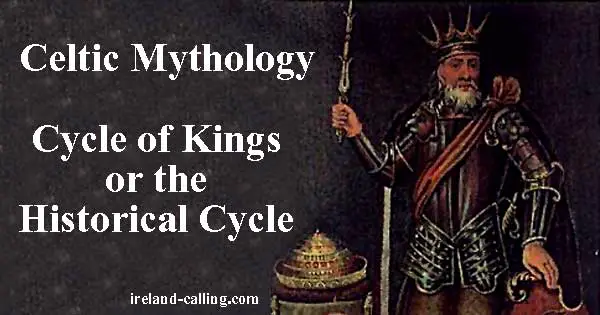The Cycle of Kings is a collection of stories about the mythical kings who ruled Ireland from about the 3rd century BC to the 11th century AD, long after the arrival of St Patrick and Christianity.
It’s one of the four great collections of Irish myths, the others being the Ulster Cycle, the Fenian Cycle and the Mythological Cycle.
Like the other collections, the Cycle of Kings is based largely on manuscripts drawn up by Irish monks between the 11th and the 15th centuries. As the name suggests, it focuses purely on the kings of Ireland and the nature of kingship.
It is a wide-ranging collection of stories but can be divided into two main sections.
The first concerns mainly the exploits of King Cormac mac Airt. The other section focuses on numerous other kings including Niall of the Nine Hostages, Conn of the Hundred Battles, and Brian Boru, or Boruma.
Some of the kings are clearly mythical; others like Brian Boru are real and historical, although the stories related to them might be far from reliable.
Kings are part historical but mainly mythical
With many of the other kings mentioned, it’s impossible to verify whether they are purely mythical or based on real, historical figures.
The life and times of Cormac mac Airt take up a large proportion of the Cycle of Kings. He may have been based on a real person who lived somewhere between the 2nd and 4th century, although the stories handed down to us are largely mythical.
He is said to have been a High King of Ireland and created the Fianna, groups of elite warriors, to defend the country. One of the key leaders of the Fianna was the legendary Finn MacCool – Fionn mac Cumhaill, in Irish.
Conn of the Hundred Battles was another legendary High King of Ireland and as his name suggests, was famous for his military prowess. The coronation stone at Tara, the ancient seat of Irish kings, is said to have roared when he stepped on it, indicating that he was the country’s rightful ruler.
According to legend, Conn was the founding father of the Connachta, the people who dominated the area to which they later gave their name, Connaught.
Naill of the Nine Hostages – rise of O’Neill clan
One of Conn’s descendants was Niall N Noígiallach, better known as Niall of the Nine Hostages. He also went on to become High King of Ireland according to legend, somewhere between the 2nd and 4th centuries AD. He is said to be the ancient ancestor of the Uí Néill, the people who were later to dominate much of north east Ireland. They eventually became known as the O’Neill clan. O’Neill is now the 9th most common name in Ireland.
There are various accounts of why Niall got the name, “of the nine hostages”. The most popular is that he took five hostages from each of the five ancient Irish provinces of Ulster, Connacht, Leinster, Munster and Meath, and then took a hostage from the Scots, the Saxons, the Britons and the Franks.
Brian Boruma, better known now as Brian Boru, was a genuine historical figure and perhaps the only person who can make a real claim to have been High King of Ireland, that is, a king in control of the whole country.
He is best remembered for breaking the power of the Vikings in Ireland at the Battle of Clontarf in 1014. Brian gave his name to the O’Brien clan. O’Brien is now the 6th most common name in Ireland.
